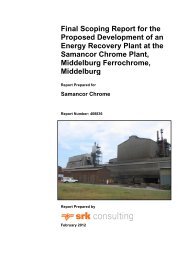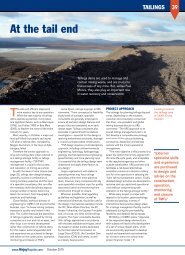Draft Status Quo Report for the Pixley Ka Seme ... - SRK Consulting
Draft Status Quo Report for the Pixley Ka Seme ... - SRK Consulting
Draft Status Quo Report for the Pixley Ka Seme ... - SRK Consulting
You also want an ePaper? Increase the reach of your titles
YUMPU automatically turns print PDFs into web optimized ePapers that Google loves.
<strong>SRK</strong> <strong>Consulting</strong> in association with BKS<br />
<strong>Pixley</strong> <strong>Ka</strong> <strong>Seme</strong> Local Municipality EMF – <strong>Draft</strong> <strong>Status</strong> <strong>Quo</strong> <strong>Report</strong> Page 8<br />
(f) Rehabilitate and restore degraded ecosystems and<br />
promote <strong>the</strong> recovery of threatened species, inter alia,<br />
through <strong>the</strong> development and implementation of plans<br />
or o<strong>the</strong>r management strategies; and<br />
(g) Develop or maintain necessary legislation and/or<br />
regulatory provisions <strong>for</strong> <strong>the</strong> protection of threatened<br />
species or populations.<br />
Convention on <strong>the</strong> Conservation of Migratory<br />
Species of Wild Animals (Bonn Convention),<br />
1979<br />
The Bonn Convention aims to conserve terrestrial,<br />
marine and avian migratory species throughout <strong>the</strong>ir<br />
range. To avoid <strong>the</strong> migratory species from becoming<br />
endangered, <strong>the</strong> parties must:<br />
• Conserve or restore <strong>the</strong> habitats of endangered<br />
species;<br />
• Prevent, remove, compensate <strong>for</strong> or minimise <strong>the</strong><br />
adverse effects of activities or obstacles that impede<br />
<strong>the</strong> migration of <strong>the</strong> species; and<br />
• Prevent, reduce or control factors (to <strong>the</strong> extent<br />
feasible and appropriate) that are endangering or<br />
are likely to fur<strong>the</strong>r endanger <strong>the</strong> species.<br />
Several Agreements have been concluded to date under<br />
<strong>the</strong> auspices of <strong>the</strong> Convention <strong>for</strong> specific species or<br />
groups of wildlife within a particular area such as <strong>the</strong><br />
African-Eurasian Migratory Waterbirds. In addition,<br />
several Memoranda of Understanding (MoU) have been<br />
concluded to date under <strong>the</strong> Convention such as Marine<br />
Turtles of <strong>the</strong> Atlantic Coast of Africa MoU.<br />
Convention on <strong>the</strong> Illegal Trade in<br />
Endangered Species (CITES), 1973<br />
International trade in wildlife and wildlife products is<br />
regulated through <strong>the</strong> Convention on International<br />
Trade in Endangered Species of Wild Fauna and Flora<br />
which accords varying degrees of protection to more<br />
than 30,000 species of animals and plants to ensure that<br />
trade does not threaten <strong>the</strong>ir survival. South Africa<br />
ratified CITES in 1975 and is a significant importer and<br />
exporter of CITES-listed species.<br />
Basel Convention on <strong>the</strong> Control of<br />
Transboundary Movement of Hazardous<br />
Wastes and <strong>the</strong>ir Disposal (1989)<br />
The Basel Convention was designed to reduce <strong>the</strong><br />
movements of hazardous waste between nations, and<br />
specifically to prevent transfer of hazardous waste from<br />
developed to less developed countries. It does not,<br />
however, address <strong>the</strong> movement of radioactive waste.<br />
The Convention is also intended to minimize <strong>the</strong><br />
amount and toxicity of wastes generated, to ensure <strong>the</strong><br />
management of waste occurs as close to <strong>the</strong> source of<br />
<strong>the</strong> waste, and to assist less developed countries in<br />
managing hazardous and o<strong>the</strong>r wastes in an<br />
environmentally-sound fashion.<br />
Convention Concerning <strong>the</strong> Protection of <strong>the</strong><br />
World Cultural and Natural Heritage (1972)<br />
The Convention aims to encourage <strong>the</strong> identification,<br />
protection, and preservation of earth’s cultural and<br />
natural heritage. It recognizes that nature and culture<br />
are complementary and that cultural identity is strongly<br />
related to <strong>the</strong> natural environment in which it develops.<br />
The Convention provides <strong>for</strong> <strong>the</strong> protection of those<br />
cultural and natural 'properties' deemed to be of greatest<br />
value to humanity globally.<br />
United Nations Convention to Combat<br />
Desertification, 1994<br />
The Convention to Combat Desertification (CCD)<br />
promotes effective action to prevent land degradation<br />
through innovative local programmes and a network of<br />
international partnerships. The CCD recognizes that<br />
ef<strong>for</strong>ts to combat desertification should complement<br />
ef<strong>for</strong>ts to protect biodiversity. The CCD advocates<br />
international co-operation and an integrated approach<br />
that is consistent with Agenda 21 of <strong>the</strong> Convention on<br />
Biological Diversity. Although <strong>the</strong> CCD addresses <strong>the</strong><br />
specific problem of desertification and drought, it also<br />
advocates research into <strong>the</strong> causes of desertification and<br />
<strong>the</strong> implementation of action plans. The Convention on<br />
Biological Diversity, having a wider scope that<br />
concentrates on habitat and ecosystem conservation,<br />
works collaboratively with <strong>the</strong> CCD by recognizing <strong>the</strong><br />
importance of understanding <strong>the</strong> value of land and<br />
scarce water resources.<br />
Convention on <strong>the</strong> Conservation of Wetlands<br />
especially as Waterfowl Habitat (Ramsar),<br />
1971<br />
The Convention provides a framework <strong>for</strong> national<br />
action and international cooperation <strong>for</strong> <strong>the</strong><br />
conservation and wise use of wetlands <strong>for</strong> <strong>the</strong> benefit of<br />
humankind. The ‘wise use’ concept refers to <strong>the</strong><br />
maintenance of <strong>the</strong> wetlands ecological character which<br />
KILI/BEAT G:\404946_PIXLEY EMF\7REPORTS\<strong>Status</strong> <strong>Quo</strong> report\<strong>Draft</strong> report\<strong>Draft</strong> status quo report, July 2010.docx July 2010









